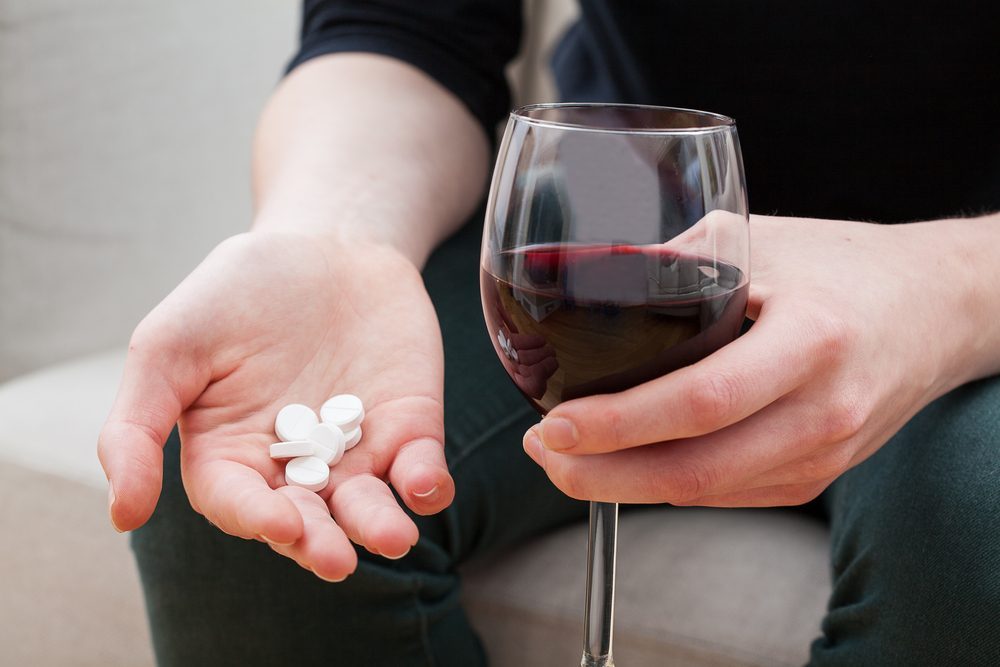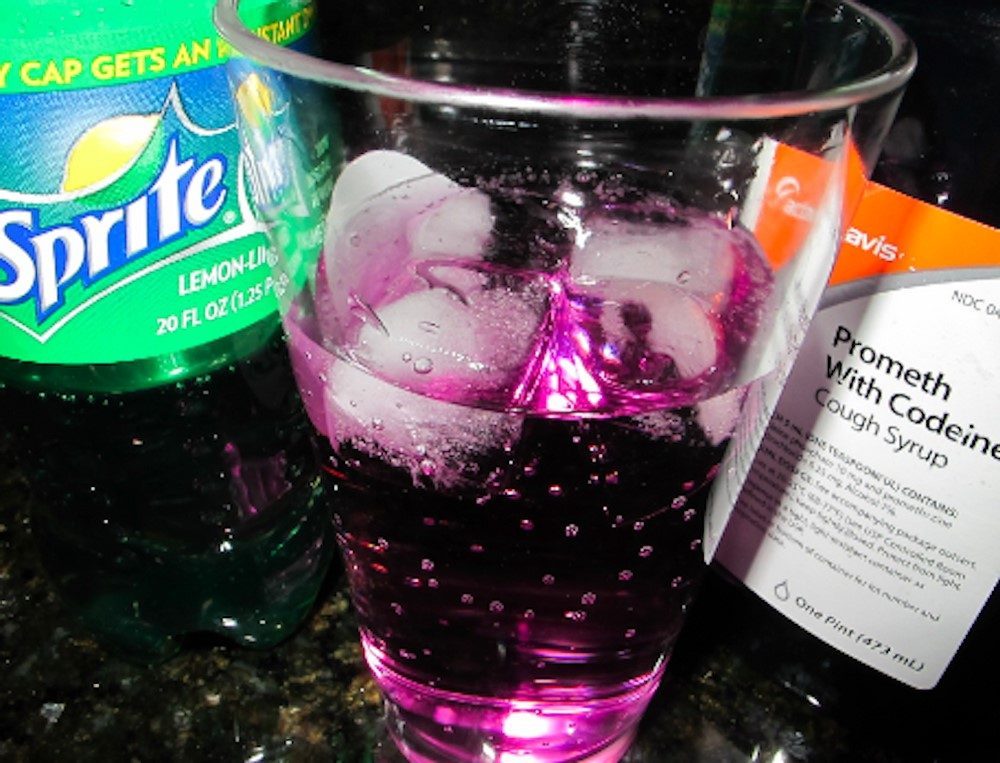
Alcohol and codeine are both central nervous system depressants and should never be mixed together. What are the dangers and effects of combining them?
Codeine is a popular over-the-counter medicine and prescription-strength painkiller.
It has sedative effects that slow down your breathing and body functions, making your brain less alert. Alcohol has similar effects, especially in large quantities.
Both alcohol and codeine produce euphoric effects, and there has been an increasing trend of mixing them to increase levels of intoxication. This can lead to all kinds of complications.
In severe cases of abuse of these two substances or where there is little tolerance to either alcohol or codeine, the side effects can be life-threatening.
Read on to find out about the effects of mixing codeine and alcohol together. You can also learn of the signs of drug and alcohol abuse and what to do if you think you may have a problem.
Some people may take codeine with alcohol simply because they want pain relief and are not educated about the dangers of mixing these two. Others intentionally mix alcohol and codeine to increase feelings of euphoria and sedation. However, they are also often unaware of the risks.
Alcohol and codeine are substances with moderate to high abuse potential. Combining codeine and alcohol increases the effect of each substance and is a potent mix that could lead to overdose and death.
Alcohol dependence is a recognised medical condition that requires medical and psychiatric treatment.
If you are physically dependent on alcohol but require pain relief, narcotic drugs such as codeine can be exceptionally dangerous to take.
Drinking large amounts of alcohol can knock you out, adding to this a painkiller such as codeine, and you are risking your life. Both of these substances slow down your respiratory rate, and when combined, there is a risk of respiratory arrest, coma or death.
Because of the risks involved with codeine when you drink regularly and heavily, it is important to be honest with your healthcare provider. They will assess if codeine is safe to take according to your alcohol consumption.
If they decide to give you the medication, they will likely give the lowest dose. They can also prescribe safer alternatives to narcotic drugs.
It is important to note that even over-the-counter codeine-containing medicines that you would buy from your pharmacy are dangerous to mix with alcohol.
Codeine is a prescription opioid painkiller and cough suppressant with a similar chemical structure to Morphine.
Codeine comes in many over-the-counter (OTC) medications and is prescribed at higher doses. To increase codeine’s efficiency, it is often combined with other mild analgesics such as paracetamol, aspirin, antihistamines and ibuprofen.
Numerous other products on the market combine codeine with aspirin, paracetamol or ibuprofen.
Several health risks have been associated with liquid codeine, which often comes in cold and flu syrups and cough mixtures. Because of this, The Commission on Human Medicines and its Paediatric Medicines Expert Advisory Group has advised that codeine-containing OTC liquid medicines should not be used for cough suppression in children and young people under the age of 18.
Codeine works by attaching to a person’s pain receptors in the brain and changing their perception of pain. It also acts as a cough suppressant and is an active ingredient in many cough syrups and cold and flu remedies.
When used as indicated, codeine can be an effective and safe medication. However, as with all opioids, prolonged use or abuse of codeine can lead to drug tolerance, dependence and addiction.
Taking Codeine without a prescription or in any way that is not directed by a healthcare professional is considered abuse.
Those who abuse codeine do so for the euphoric effect that the drug produces.
Repeated codeine abuse becomes habit forming. However, because opioid drugs quickly cause drug tolerance, a person who abuses codeine will find themselves having to take more and more over time. They may also turn to mix codeine with more alcohol to gain the desired effect. This places them at high risk of developing codeine dependence and addiction.

Lean and alcohol are both very addictive substances, especially when they are combined together.
Lean, aka “purple dank”, is a popular homemade drink with teenagers, promoted in the lyrics of American rap culture. The active substance in lean that primarily causes intoxication is codeine.
The ingredients for Lean are, unfortunately, legal, meaning they are easy to obtain, make, and consume. Lean, also known as purple Dank, sizzurp and Dirty Sprite, is made from cough syrup containing codeine combined with a fizzy drink such as Sprite. Lean is sometimes flavoured with hard candy sweets like Jolly Ranchers.
The internet contains recipes for making Purple Dank, Lean, or Dirty Sprite, with variants to the drink’s ingredients.
Lean alone is very addictive. Mix it with alcohol, and you not only have one very intoxicating drink but a drink that could lead you down a very dark path.
The codeine in Lean is an opiate analgesic and habit-forming. Codeine is also a central nervous system depressant and can slow down your breathing and cause respiratory difficulty. Alcohol also has depressant effects. The combined effects of alcohol and codeine increase your risk of overdose and respiratory arrest.
Promethazine, which is often contained in codeine cough linctus, is an antihistamine. Antihistamines may cause drowsiness and, when combined with codeine and alcohol, can lead to excessive sleepiness, confusion, dizziness and respiratory depression.
Research shows that Alcohol Use Disorders, Opioid Use Disorders and chronic pain management are all significant public health problems in their own right. However, there is little research in terms of the co-use of alcohol and opioids.
Long-term use of opioids can increase pain sensitivity, as can opioid withdrawals. This can lead a person to take more opioids in a bid to deal with the pain, when in fact, a substantial part of the pain can be relieved by ceasing opioid use.
Opioids such as codeine play a significant role in the management of chronic pain. Many of the people who take opioids long-term will also drink alcohol. They are unlikely to be aware of the full extent of the risks involved.
What we do know is that almost half (45.7%) of the deaths recorded for drug overdose in England and Wales for 2021 involved an opioid. This equates to 2,219 drug poisonings that involve an opiate drug. This figure increases to 61% when deaths that involve no drug type are excluded.
Codeine-related deaths have increased by almost 25 per cent in the past year (2020), according to the Office for National Statistics. This is a record high of 212 people who died from codeine poisoning in England and Wales.
Spikes in codeine-related deaths have been attributed to the increased availability of the drug on the dark web and the mixing of codeine with other substances, such as alcohol or benzodiazepines.
In Scotland (2021), 93% of all drug misuse deaths were caused by more than one drug in the body. 83% of these deaths found that an opioid or opiate was present.
The message is clear – mixing drugs, especially opioids, with another depressant drug, such as alcohol or benzodiazepines, is very dangerous. It can ultimately cause death.
Repeatedly abusing alcohol or codeine runs a high risk of developing an addiction to either substance. Mixing them both together increases this risk further.
Having an addiction to both alcohol and codeine carries a high risk of overdose due to the combined depressant and sedative effects of each substance.
If you think you or someone you love is abusing codeine and alcohol, it is important to seek help immediately. Substance use disorders and addiction only become progressively worse over time without treatment and intervention.
The signs of codeine and alcohol addiction can affect a person’s physical and mental health, behaviour, occupation or education, and their financial stability.
Whilst Codeine is one of the weaker opioid painkillers available, especially at over-the-counter strengths, it is still possible to overdose on the drug if it is abused. Mixing prescription-strength codeine with alcohol is especially dangerous.
If you or someone you know is abusing codeine and alcohol, it is important to know the signs of an overdose so that you can get immediate emergency medical attention.
Mixing alcohol and Codeine is extremely risky as it intensifies the effects of each substance. This, in turn, increases the risk of overdose and developing long-term health complications.
Alcohol also increases the speed at which opioid painkillers are released into the bloodstream, causing codeine to be released rapidly. This results in dangerously high blood intoxication levels, primarily affecting the brain’s ability to function normally.
Combining alcohol and codeine can also cause breathing issues, meaning that the brain and organs do not get sufficient oxygen. It is this that can lead to respiratory arrest.
Withdrawal from codeine is much the same as any other opioid withdrawal. You will likely feel the most intense withdrawals within the first week after cessation. Following this, the withdrawal will gradually diminish over time. The severity of your codeine withdrawal will depend on how much codeine you take and the duration you have taken it for.
In addition to physical codeine withdrawal symptoms, you are likely also to experience psychological symptoms, which include dysphoria, depression, lack of motivation, cravings and increased anxiety levels.
Alcohol is one of the most dangerous substances to withdraw from, along with benzodiazepines and opioids. If not managed correctly within a medical environment, alcohol withdrawal symptoms can lead to seizures and even death.
There are some very effective treatments available for both alcohol addiction and codeine addiction. These treatments combine approved pharmaceuticals with evidence-based therapies.
In cases where there is co-occurring use of codeine and alcohol, withdrawal can be extremely uncomfortable and dangerous if attempted at home.
Being addicted to one substance is hard enough. We understand this better than most, but dual addiction can be challenging to overcome.
Due to the risks involved in detoxing from alcohol and codeine, inpatient detoxification is the safest method.
Our medical detox facilities assess patients for dual diagnosis conditions, underlying health conditions and polydrug use. Medical detox is then prescribed and administered by qualified healthcare professionals with 24/7 care.
Every person that we treat is evaluated on an individual basis to ensure that they receive the best treatment for them as a person.
To find out more about how we can help you or a loved one overcome an addiction to alcohol and opioids, please call or message us for a free and confidential assessment.
We have many different rehabs and detox clinics covering many locations. Following an in-depth telephone assessment, we can make appropriate recommendations for your treatment needs, location and budget. We will ensure that you get the right treatment to set you up for long-term recovery.
GET HELP TODAY. 24 Hour Helpline: 0207 2052845